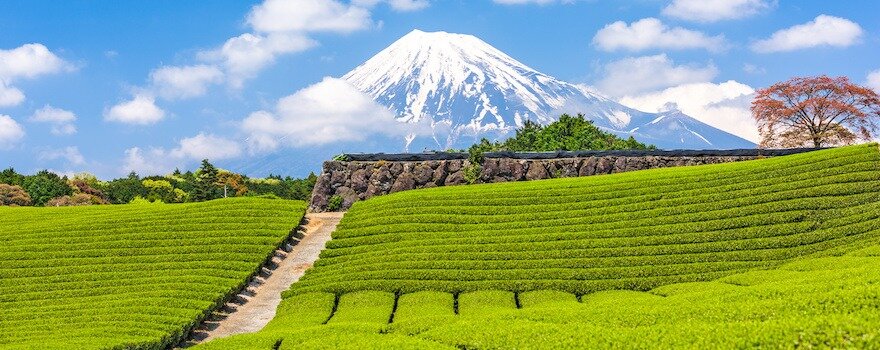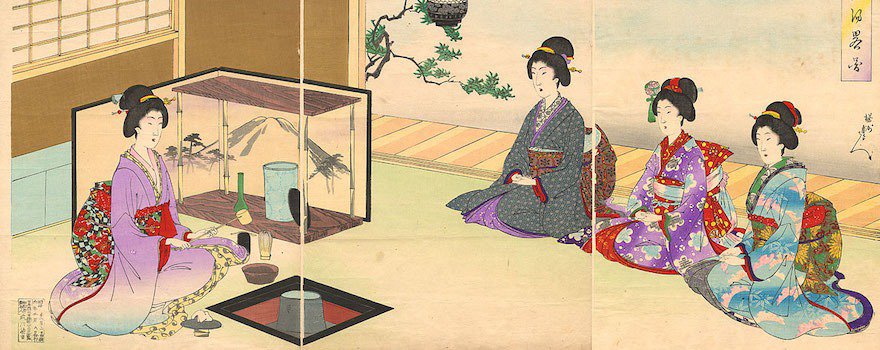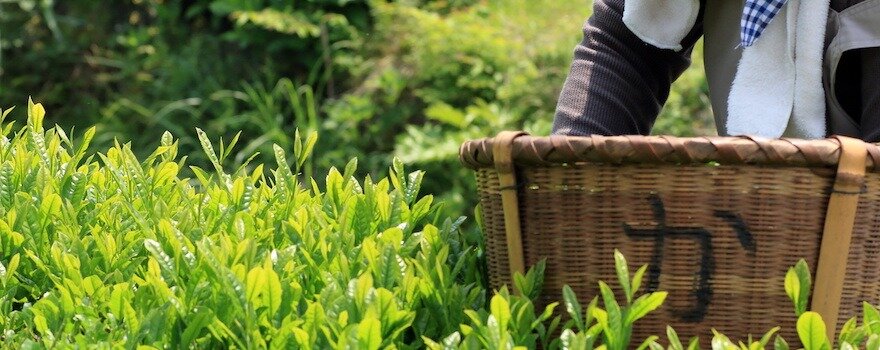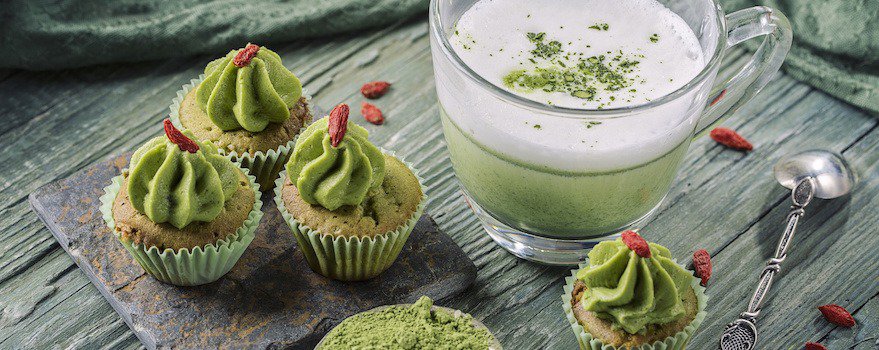BENEFITS OF MATCHA
✓ Stimulates brain function
✓ A powerful antioxidant
✓ Detoxifying and good for the liver
✓ Protects the heart and helps burn fat
✓ May help prevent cancer
What is matcha?
The matcha is the name given to a fine green powder originating from Japan, obtained by grinding dried leaves of green tea (Camellia sinensis). Beyond its form, its distinguishing feature compared to “regular” green tea is its cultivation method: the tea bushes are covered about twenty days before harvest.
This technique, by blocking direct sunlight, slows leaf growth and helps boost the production of chlorophyll and amino acids. It becomes a kind of ultra-concentrated green tea, which gives matcha exceptional properties.

The leaves thus obtained are called tencha, darker than usual, unfolded and completely dried. Then, traditionally, they are ground on stone mills. It is said that the best matcha comes from Nishio, south of Nagoya.
Matcha was born at the end of the 12th century, when the monk Eisai made a journey to China and brought back to Japan both the ideas of Zen Buddhism and the technique of powdered tea. It was quickly incorporated into the rituals of Buddhist monasteries, notably that of meditation, because it was said to help keep monks awake.

As early as the 13th century, matcha was also consumed by the samurai, the famous Japanese warriors, to increase their physical strength and concentration. It is also central to the tea ceremony, a highly codified traditional art in which a master prepares and serves it to a small group of people in a calm, zen-like atmosphere.
Its method of production gives it a very high concentration of antioxidants, polyphenols, flavonoids, catechins, chlorophyll, amino acids…
Today matcha is present everywhere in Japan, as self-service infusions in restaurants, in desserts and treats… It’s even found in Kit-Kats and Oreos — not very superfood! It has an umami flavor. Also known as the 5th basic taste, alongside sweet, salty, bitter, and sour.
Matcha is said to be good for the mind and mood. It is recommended both to students and to older adults for its stimulating and calming effects at the same time. Also to people who want to lose weight or maintain a healthy weight. It is becoming increasingly popular here as studies continue to confirm its benefits for our bodies.
Nutritional composition
- Amino acids: theanine…
- Caffeine
- Antioxidants: chlorophyll, polyphenols (flavonoids), catechins…
Matcha benefits
★ Stimulates brain function
Matcha improves certain brain functions, notably thanks to the caffeine and the theanine it contains.
It is more concentrated in caffeine than green tea: there are about 35 mg per 1 g, which is half a teaspoon. This will help improve our reaction time, attention, and memory.
It is also very rich in theanine (L-theanine, not to be confused with theine), an amino acid that contributes to relaxation and stress reduction. It is particularly compatible with caffeine because it helps reduce its side effects.
It wakes us up while calming us: that’s why matcha has long been considered a ally for meditation.
This study by Wageningen University in the Netherlands, conducted on 23 people, showed that those who consumed matcha had better attention, responsiveness, and memory. This one, conducted by the Unilever Food and Health Research Institute in the Netherlands, demonstrated that theanine acts directly on the brain, calming our mind without causing drowsiness.
★ A powerful antioxidant
Matcha is a remarkable source of antioxidants! It is particularly rich in catechin, a flavonoid that gives it its umami taste. It is also rich in chlorophyll, the natural pigment that gives it its green color, and which also contains antioxidants such as carotenoids.
Antioxidants help fight free radicals and protect our cells from aging and chronic diseases.
Again, matcha is more concentrated in antioxidants than green tea, which is already rich in them!
This study by the Zhejiang Tea Science Society in China, conducted on mice, demonstrated that consuming matcha reduces damage caused by free radicals and improves metabolism and the body’s antioxidant activity.
★ Detoxifying and good for the liver
Matcha supports proper liver function, protects it, and helps eliminate toxins. It helps rebalance and purify the body.
It’s a detox food par excellence. It is recommended to cleanse the body after overindulgence or on an ongoing basis. Its detox properties are mainly attributed to catechin. A matcha regimen can also improve the appearance of the skin.
This study from Toyama University in Japan, conducted on rats, showed that taking matcha helps protect the liver and kidneys. This one, conducted by various Chinese universities, showed that green tea reduces the risk of liver disease.

★ Protects the heart and helps burn fat
Consuming matcha helps reduce the risk of heart disease and protect the heart. These properties are attributed to the many antioxidants it contains.
Green tea powder also helps burn fat faster, it speeds up metabolism and boosts our energy. Thus matcha for people who want to lose weight. Here too the catechin comes into play.
This meta-analysis from Maastricht University showed that regular consumption of green tea helps to lose weight and maintain a healthy weight.
★ May help prevent cancer
Green tea, and more specifically matcha, are natural means of preventing the onset of cancers and limiting the spread of cancer cells.
Their anti-cancer properties are under study, and they have been demonstrated in in vitro experiments and in animal studies. These are real leads in cancer research.
These virtues are still and always attributed to catechin, which matcha is rich in – and which is also found in cocoa and guarana.
This study in vitro from the University of Wisconsin demonstrated that the catechin present in matcha helps eliminate cancer cells.
How to consume it?
Prefer organic matcha

As with all our food, it’s preferable to choose products from organic farming, free from pesticide residues and respectful of the environment. In this case, drinking organic matcha is particularly recommended, since tea leaves are very absorbent. They may therefore contain pesticide residues or lead depending on the soils in which they grow.
Read also the From a Japanese farm to Nature & Découvertes, the lovely story of Camille’s organic matcha
The matcha boom on the market is encouraging the emergence of industrial farming that mass-produces products without concern for nutritional, health, and environmental quality. Therefore, it’s recommended to trust labels that certify a product as 100% organic.
Young Japanese farmers created a cooperative, Matcha Organic Japan, which ensures organic, fair-trade cultivation of matcha. Some French brands are also vigilant and committed on this issue.
Matcha preparation

Unless you’re a purist and want to mimic the tea ceremony, it couldn’t be simpler! Heat water to 80°C – almost simmering, pour it into a bowl then mix in one teaspoon of matcha. Whisk the matcha vigorously until it’s frothy, and it’s ready.
The process is more sophisticated during the tea ceremony. In broad terms: the matcha is kept in a container, it is sifted through a steel sieve over the bowl, a little hot water is added and the mixture is emulsified with a bamboo whisk until the matcha is free of lumps and the rim of the bowl is clean.
You can also easily mix the powder into yogurt or your smoothie, which it will color beautifully!
Desserts, pastries, and matcha latte

Surprisingly, it was desserts and pastries that popularized matcha here. Eclairs, cookies, cakes, financiers, ice cream, cupcakes… Usually you just need to incorporate the matcha powder into the flour or milk when preparing your dessert.
As for Matcha Latte, it is becoming increasingly popular in cafes and tea shops. You can make it yourself by mixing matcha powder, hot milk, and coconut sugar!
Dosage
Because it’s a concentrated food, it’s recommended to drink at most 2 or 3 cups per day.
Contraindications and side effects
At recommended doses, there are no notable contraindications or side effects. However, its high caffeine content may cause diarrhea. If you are pregnant or breastfeeding, consult your doctor.



